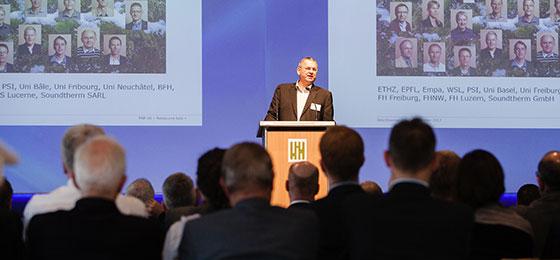Plaudits at the end of NRP 66 “Resource Wood”

The motto of the closing event of NRP 66 was "Wood has added value". The well-attended event took place on 7 November 2017 in the Berner Eventfabrik.
"I am very impressed with the results of NRP 66," said Katharina Fromm, Vice President of the National Research Council and President of the Programmes division. On behalf of the Swiss National Science Foundation (SNSF), she welcomed the many guests from research, industry and public authorities in Bern. With reference to her academic background in chemistry, she added that she found the many different uses of wood, as shown by NRP 66, very exciting. She thanked everyone - the Steering Committee, the researchers and the dialogue partners - for their contribution to this most wide-ranging programme.
"Wood will play an important role on our path towards a green economy. This is clearly shown by the 30 projects and the programme syntheses of NRP 66," said Martin Riediker, President of the Steering Committee of NRP 66. "But we need an innovative and diversified manufacturing industry to realise this great potential. Otherwise large quantities of wood will remain unused in Swiss forests," he warned in his summary of seven years of intense work.
He feels encouraged by the individual results as well as by the numerous R&D partnerships with industry which were established in the course of the programme. To underline this point, he referred to the 14 new CTI projects and the four start-up companies that had emerged from NRP 66 so far. He also mentioned the approx. 200 representatives from industry, trade organisations and public authorities that participated in the various dialogue events, some of whom were closely involved in the synthesis process of the programme. Looking back he found it particularly important that the programme was able to attract interest from companies and research groups that would not normally be interested in wood as a resource. He also said that it was very important to maintain these new networks that go beyond the traditional boundaries of wood research and industry.
In addition, the overall programme summary and the four thematic syntheses were published in the context of the closing event.
The author of the thematic synthesis "New developments in timber construction", Andrea Frangi of ETH Zurich, said that timber construction still had great potential, both in terms of materials and processes (keyword: digitalisation). In view of greater urban concentration and the need for multi-storey buildings, he believes that wood is often the ideal building material, pointing out that timber had become increasingly competitive compared to concrete and steel.
Michael Studer of HAFL Zollikofen presented the synthesis "Novel ways of bio-refining wood" along with potential platforms and products. He argued that Switzerland was too small for a large-scale plant, but regionally linked smaller plants could play an important role in adding value to plentiful hardwood stocks.
Ingo Burgert of ETH Zurich and author of the synthesis "Innovative wood-based materials" pointed out that wood needed to play an important role in replacing oil-based materials. He added that the great challenge was to develop new wood-based materials into market-ready products by finding suitable process technologies and that everybody involved needed to rise to this challenge.
Philippe Thalmann of EPF Lausanne and author of "Provisioning and sustainable use of wood" confirmed that the results of NRP 66 underlined in many ways the ecological advantages of an intelligent use of wood. The research had also shown that managing larger areas would increase efficiency in the wood sector.
How relevant are the results and the overall process of NRP 66 in an international context? Charlotte Bengtsson of Skogforsk in Uppsala (Sweden) and Alfred Teischinger of BOKU Wien (Austria), both members of the Steering Committee, offered an appraisal from an outside perspective. They were impressed by the quality of the results and the spirit of interdisciplinarity. In their view, the extensive dialogue with industry partners and other experts in writing the programme syntheses and recommendations was unique. But they identified a lack of international visibility: they believe that European companies are not really aware of the work because the dialogue was focused on Switzerland.
The closing panel debate was moderated by Judit Solt, editor-in-chief of TEC21. The panel included FOEN director Marc Chardonnens, environmental engineer Stefanie Hellweg (ETHZ), Katharina Lehmann of Blumer-Lehmann AG, Ludwig Lehner of bwc GmbH, SP National Councillor Eric Nussbaumer, Tobias Wolfinger of Weidmann AG, Philippe Thalmann of EPFL and Martin Riediker representing NRP 66.
The debate included statements such as "Don't worry about the price of wood, it's only a distraction." "A planned economy is not the solution, it's up to companies to make it work." "A reasonable CO2 levy would be the best way to promote the use of wood." "If we offer more subsidies to forestry businesses, we only maintain old structures." "Cascaded use also has its limitations." "It's now up to politicians to promote implementation." Even though the panel members didn't all agree on the best way forward, they shared the impression that NRP 66 had produced important results that could lead the way towards a better use of wood and that important steps towards industrial implementation had already been made.
What's the legacy? A number of recommendations such as establishing a biorefinery centre of competence or a national centre of timber innovation. In addition, NRP 66 has called for a Swiss bioeconomy strategy in which wood plays an important role. The programme would also like to see the continuation of the dialogue platforms, support for SMEs in accessing research and much more. The next day, a colloquium on the Gurten in Bern addressed the ways in which the national network S-WIN could facilitate implementation.
- Press release, 7 November 2017
- Programme summary (in German) (PDF) (PDF)
- Programme summary (in French) (PDF) (PDF)
- Thematic syntheses (in German and French)
- Slide show of closing conference
